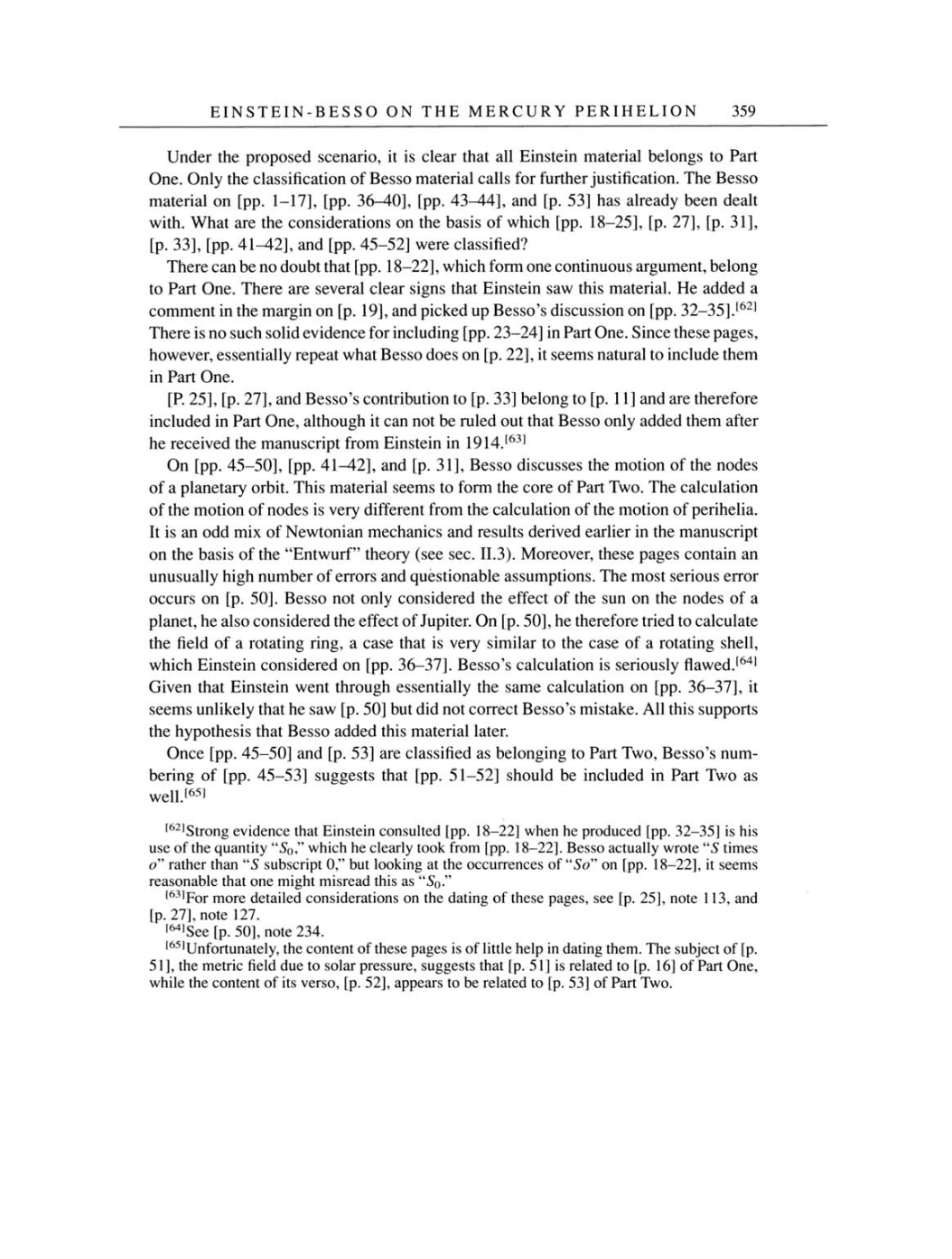EINSTEIN-BESSO
ON THE
MERCURY PERIHELION
359
Under
the
proposed
scenario, it
is
clear that
all
Einstein
material
belongs
to Part
One.
Only
the
classification of Besso material calls for further
justification.
The
Besso
material
on [pp.
1-17],
[pp.
36-40],
[pp.
43-44],
and
[p.
53]
has
already
been
dealt
with.
What
are
the
considerations
on
the
basis of
which
[pp.
18-25],
[p. 27], [p. 31],
[p.
33], [pp.
41-42],
and
[pp.
45-52]
were
classified?
There
can
be
no
doubt that
[pp.
18-22],
which
form
one
continuous
argument, belong
to
Part
One.
There
are
several
clear
signs
that Einstein
saw
this
material.
He
added
a
comment in the
margin
on
[p.
19],
and
picked
up
Besso's discussion
on [pp.
32-35].[62]
There
is
no
such
solid
evidence
for
including
[pp.
23-24]
in Part One. Since
these
pages,
however, essentially repeat
what Besso does
on [p.
22],
it
seems
natural
to
include them
in
Part
One.
[P.
25],
[p.
27],
and
Besso's contribution
to
[p.
33] belong
to
[p.
11]
and
are
therefore
included
in Part One,
although
it
can
not be
ruled
out
that Besso
only
added
them after
he
received
the
manuscript
from Einstein in
1914.[63]
On
[pp.
45-50],
[pp.
41-42], and
[p.
31],
Besso discusses
the
motion of
the
nodes
of
a
planetary
orbit.
This material
seems
to
form
the
core
of
Part
Two. The
calculation
of
the
motion of
nodes
is
very
different
from the
calculation of
the
motion of
perihelia.
It
is
an
odd
mix
of Newtonian mechanics and results derived earlier in
the
manuscript
on
the
basis of
the
"Entwurf"
theory (see
sec.
II.3).
Moreover,
these
pages
contain
an
unusually high
number of
errors
and
questionable assumptions.
The
most
serious
error
occurs on [p.
50].
Besso
not
only
considered the effect of the
sun on
the
nodes of
a
planet,
he also
considered
the
effect of
Jupiter.
On
[p.
50],
he
therefore tried
to
calculate
the field
of
a
rotating ring, a
case
that
is
very
similar
to the
case
of
a rotating shell,
which Einstein considered
on
[pp.
36-37].
Besso's calculation
is
seriously
flawed.[64]
Given
that Einstein
went
through essentially
the
same
calculation
on
[pp.
36-37],
it
seems unlikely
that
he
saw
[p.
50]
but did not correct
Besso's mistake.
All this
supports
the
hypothesis
that Besso added
this
material
later.
Once
[pp.
45-50]
and
[p. 53] are
classified
as
belonging
to Part
Two,
Besso's
num-
bering
of
[pp.
45-53] suggests
that
[pp.
51-52]
should
be
included
in Part Two
as
well.[65]
[62]Strong
evidence that Einstein consulted
[pp.
18-22] when he produced
[pp.
32-35]
is
his
use
of
the
quantity
"S0,"
which
he
clearly
took
from
[pp.
18-22].
Besso
actually wrote
"S
times
0" rather than "S
subscript 0,"
but
looking at
the
occurrences
of "S0"
on [pp.
18-22],
it
seems
reasonable that
one
might
misread
this
as
"S0."
[63]For
more
detailed considerations
on
the
dating
of these
pages, see [p.
25], note 113,
and
[p. 27], note
127.
[64]See
[p.
50],
note 234.
[65]Unfortunately,
the
content
of these
pages is
of little
help in dating
them. The
subject
of
[p.
51],
the
metric
field due to
solar
pressure, suggests
that
[p. 51]
is
related
to
[p.
16]
of
Part One,
while
the
content
of
its
verso,
[p. 52],
appears to
be
related
to
[p.
53]
of
Part
Two.
